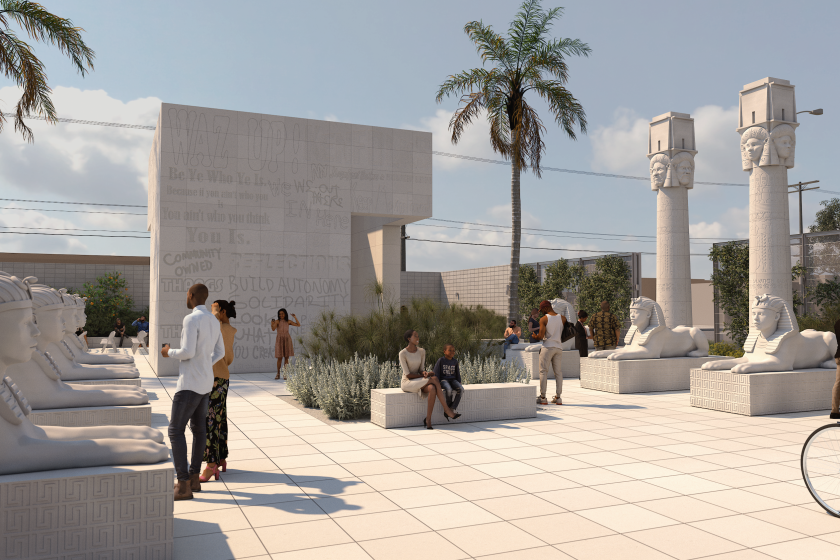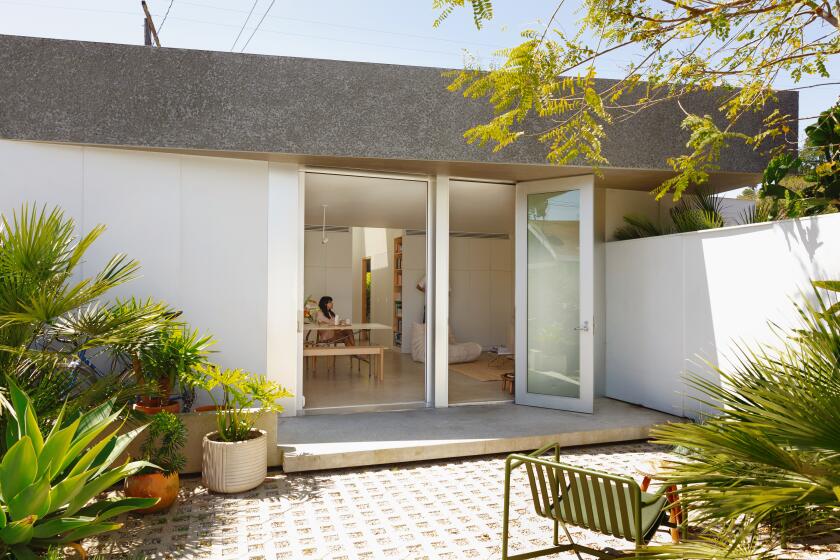‘Circuit City’ Becomes Activists’ Rallying Cry : Development: The electronics store built last year despite residents’ protests is now shorthand for an aesthetic nightmare or perceived government wrongdoing.
It has become almost a mantra among Thousand Oaks gadflies.
Again and again, activists fighting this development or protesting that policy stand before the City Council with a grim warning: “Don’t let this one become another Circuit City.”
The analogy packs a double whammy.
In Thousand Oaks, Circuit City has become shorthand for an aesthetic nightmare. Fury about the Hillcrest Drive store’s design has abated since the building was completed, but residents still refer to potential eyesores as “Circuit Cities.”
The electronic store’s name has also become a catchall term for perceived wrongdoing in city government. Circuit City is bandied about to refer to back-room dealings, secret pacts or closed-session negotiations that shut out the public.
With this double dose of negative connotations, the Circuit City rallying cry remains potent even though residents seem to have accepted the store.
“It’s a cloud over the City Council’s head, and it always will be,” said Manny Ferrara, who led the charge against the Circuit City outlet last summer with a group called Concerned Citizens of Thousand Oaks.
The fury erupted when neighbors drove by the corner of Lynn Road and Hillcrest Drive one morning to see cinder-block walls going up on a parcel they had long cherished as a scenic gateway to the community.
The more they investigated, the more they found to hate.
Residents were outraged at the building’s design, which they said looked like a prison and blocked views of the mountains. They were incensed that the city had failed to notify most neighbors of a public hearing on the development. And they were angry at the convoluted land transactions that put the parcel in Circuit City’s hands.
They picketed the construction site, denounced city leaders and forced the council to call a special study session to explain the history of Circuit City.
Now, almost a year after the brouhaha, the frustrations have been replaced by a sense of quiet triumph.
“Some positive things have come out of the whole situation,” said Ken Bauer, another outspoken opponent of the project.
For one, Circuit City accepted 178 conditions and modified its design to fit in with the rest of Thousand Oaks--buff-colored earth-tone walls, a red-tile roof, and a well-landscaped parking lot. The trademark red-tile tower that characterize most Circuit City outlets was eliminated, replaced by a subdued tile pattern around the entrance.
Building the Thousand Oaks store to such stringent standards cost $4 million, significantly more than other outlets, Circuit City spokeswoman Julie Mullian said.
The results please even the toughest critics.
“The building as it sits now is 100% better than when it was first proposed, even though I still feel it does not fit with the original intent of what that property should be used for,” said Don Davis, another Concerned Citizens leader.
Even more important than the aesthetic modifications, city leaders responded to the uproar by changing notification procedures in an effort to alert residents to upcoming public hearings.
Large signs describing proposed projects are now placed on every parcel up for development. And the council is mulling other steps, such as increasing the number of newspaper ads announcing public hearings.
“Although there was so much disillusionment and loss of faith (during the Circuit City protests), there is a benefit in terms of better notification,” said Councilwoman Jaime Zukowski, who announced her candidacy in front of the Circuit City store and rode anti-incumbent sentiment to victory in November.
“Also, people now see that although Thousand Oaks is known for its planning, we’re under tremendous pressure to relax our standards, and it will take real citizen involvement to sustain them,” Zukowski added.
Seven months after the Circuit City store opened, residents seem to have accepted it, shopping there for everything from vacuum cleaners to big-screen televisions.
“The Thousand Oaks store has outperformed our expectations--we feel it has been warmly received by the community,” spokeswoman Mullian said. She declined to disclose sales figures.
Some satisfied customers wonder what the flap was all about.
“It was ridiculous,” said Thousand Oaks resident Robert Lunbeck, as he trudged inside to buy a VCR. “There was nothing here before but a big mud hole, and now it’s a very attractive building.”
Ojai resident Rich Mazzola, who lived in Thousand Oaks during the controversy last summer, said he couldn’t understand the concern about building retail stores on so-called gateway lots.
“If you’re going to develop anything, you might as well develop the land nearest the freeway,” Mazzola said as he entered Circuit City to purchase a phone. “It’s a good-looking building, not an eyesore.”
More to Read
Start your day right
Sign up for Essential California for news, features and recommendations from the L.A. Times and beyond in your inbox six days a week.
You may occasionally receive promotional content from the Los Angeles Times.






